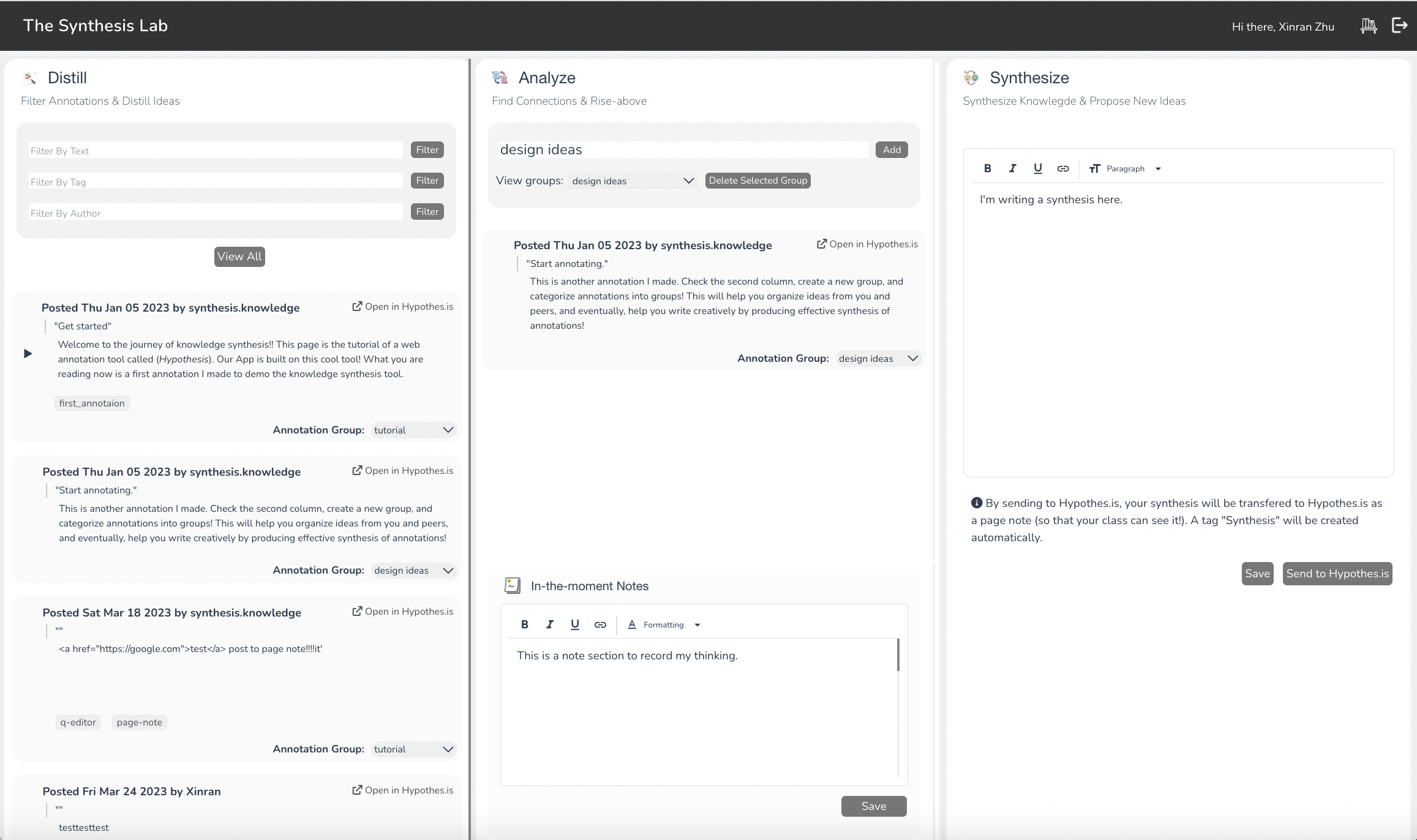Synopsis
Social annotation is a genre of information technology that allows a user to annotate information in a shared document and anchor a discussion to the annotated information. When it is used socially in online classrooms, web annotation can support social reading, group sensemaking, knowledge construction, community building, and collaborative learning.
To support several instructors’ pivot to online teaching since Fall 2020, we conducted the study that was focused on engaging undergraduate students in reading and discussing course materials in online classes through collaborative social annotation activities. Following a co-design approach, we have been working closely with instructors to design supports in both pedagogy and technology for social annotation activities and support them to implement the designs, with course-specific customizations, in their classes. All participating courses are piloting a web annotation tool named Hypothes.is that allows students to read and annotate socially. This project is currently moving forward in several exciting directions:
💬 Designing a Generic Scaffolding Framework – The Participation Roles Strategy
We designed a generic scaffolding framework comprising three scripted participation roles based on the CSCL literature (Strijbos & Weinberger, 2010; Wise et al., 2012). These roles are: a facilitator responsible for stimulating conversations by finding connections, seeking clarifications, and encouraging their peers to consistently tag their annotations for an entire week; a synthesizer who synthesizes the initial ideas, highlights agreement/disagreement, and suggests directions of further discussions in the middle of the week; and a summarizer who summarizes group conversations at the end of the week for the whole class.

🔧 Designing a Technology Support for Knowledge Synthesis – The Synthesis Lab
The Synthesis Lab is a tool for knowledge synthesis in collaborative sense-making and knowledge building. It aims to support the creation of knowledge synthesis, which does not only summarize existing ideas but also investigates connections across sources and generates novel knowledge, akin to the notion of “rise-aboves” in knowledge building (Scardamalia & Bereiter, 2014). As a scaffolding tool, the tool emphasizes the indispensability of connecting ideas and guides students through the key steps of making generative synthesis, including searching for relevant ideas, connecting, categorizing and rising above scattered ideas, and writing up the synthesis.
Check out the blurb with a demo!

📊 Developing Analytical Frameworks to Understand Collaborative Discourse
Social annotation technologies provides learners with extensive opportunities to share and improve their ideas through collaborative discourse. There are emerging interests in the CSCL community to measure idea creation as both learning processes and outcomes. Rooted in the social constructivism perspective, we see idea creation as a product of emergent and interactive socio-cognitive endeavors, rather than a standalone and static text message. This means that it is critical to not only analyze the texts themselves but also to capture the contextual information, including both social, cognitive, and cultural aspects. Therefore, our team is dedicated to developing comprehensive analytic frameworks that depict the emergent and interactive nature of idea creation in collaborative discourse, by leveraging the natural language processing techniques and networked methods.
🏫 Designing an Interactive Teacher-facing Dashboard for Social Annotation Activities
The synergy of learning design, teacher inquiry, and learning analytics has a positive impact on instructors as designers and practitioners as well as the learning of students. Learning analytics dashboard developed nowadays, however, could not answer teachers’ inquiries into the learning process of students and provide a holistic information for the alignment between learning design and learning analytics (Macfadyen et al, 2020; Nguyen et al., 2020).
Under the framework of Activity-centered Analysis and Design—ACAD (Goodyear & Carvalho, 2014), we co-design with instructors a teacher-facing learning analytics dashboard for social annotation activities. The innovation of our dashboard is to have a design page and an analytics page that allow teachers to better keep track of students’ reading and discussion and know more about students’ perception toward learning materials and activities.
On the design page, instructors can input important design elements that generate a baseline for the learning process of students in social annotation activities. On the analytics page, instructors can easily see the difference between the activities designed and the performance of students in real time. Memo of reflection on the learning design and practice can be taken down on the dashboard while viewing the data. Instructors can also choose to share the learning design and memos with other instructors.
Partners
- College of Liberal Arts, University of Minnesota
- College of Education and Human Development, University of Minnesota
- School of Public Health, Duke University
Presentations
-
We presented our paper Socio-Semantic Network Motifs Framework for Discourse Analysis at LAK22: 12th International Learning Analytics and Knowledge Conference in March, 2022.
-
We presented our paper Designing Support for Productive Social Interaction and Knowledge Co-construction in Collaborative Annotation at the 29th International Conference on Computers in Education in November, 2021. [Slides]
-
Zhu, X., Shui, H., & Chen, B. (2021, June). Designing Support for Productive Social Interaction and Knowledge Co-construction in Collaborative Annotation. Panel presentation at the I Annotate 2021 Conference, Online. [Slides]
-
We participated the Liquid Margin, a show gathers talk about collaborative social annotion hosted by Hypothes.is to share our practice and research. In this eposide, we focused on how learning scientists and instructors can partner to successfully implement and use social annotation in diverse disciplines across higher education. See video recording.
Publications
- Zhu, X., Shui, H., & Chen, B. (2023). The Synthesis Lab: Empowering collaborative learning in higher education through knowledge synthesis. Proceedings of Computer Supported Cooperative Work and Social Computing (CSCW’23 Companion) (pp. 245-248).
- Zhu, X., Shui, H., & Chen, B. (2023). Beyond reading together: Facilitating knowledge construction through participation roles and social annotation in college classrooms. The Internet and Higher Education, 100919.
- Chen, B., Zhu, X., & Shui, H. (2022). Socio-Semantic Network Motifs Framework for Discourse Analysis. In LAK22: 12th International Learning Analytics and Knowledge Conference (LAK22), March 21–25, 2022. https://doi.org/10.1145/3506860.3506893
- Zhu, X., Shui, H., & Chen, B. (2021). Designing Support for Productive Social Interaction and Knowledge Co-construction in Collaborative Annotation. In Rodrigo, M. M. T. et al. (Eds.). Proceedings of the 29th International Conference on Computers in Education. Asia-Pacific Society for Computers in Education. [Best Student Paper Award & Best Paper Nomination]
- Zhu, X., Shui, H., & Chen, B. (2020, preprint). A Scaffolding Framework for Social Annotation in Online Classes. EdArXiv. https://doi.org/10.35542/osf.io/zk4vj
- Zhu, X., Chen, B., Avadhanam, R. M., Shui, H., & Zhang, R. Z. (2020). Reading and connecting: Using social annotation in online classes. Information and Learning Sciences, 121(5/6), 261–271. https://doi.org/10.1108/ILS-04-2020-0117
- Chen, B. (2019). Designing for Networked Collaborative Discourse: An UnLMS Approach. TechTrends, 63(2), 194–201. https://doi.org/10.1007/s11528-018-0284-7






